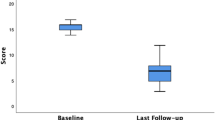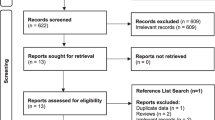Abstract
Background
Faecal incontinence (FI) affects 1–19% of the general population and carries significant physical and psychological morbidity. Treatment strategies vary greatly with respect to morbidity and efficacy and relatively little is known regarding the role of mechanical devices such as anal and vaginal inserts. This is an up-to-date systematic review of the use of these devices in the management of patients with FI.
Methods
A systematic electronic search was performed of the Medline, Pubmed and Embase databases using the key words and/or MeSH ‘anal plug’, ‘anal insert’, ‘vaginal insert’ and ‘faecal incontinence’. Only articles that reported clinical outcomes for these devices for FI in the English language were included. Review articles were excluded to avoid duplication of data.
Results
Thirteen articles fulfilled the eligibility criteria. Two articles reported outcomes for the Eclipse vaginal insert and 11 articles reported on three types of anal inserts; the Coloplast ‘Tulip’ design (6), the Procon/ProTect device (2) and the Renew insert (3). When tolerated, both anal and vaginal inserts significantly improved continence, bowel function and quality of life where reported. Adverse effects included discomfort, leakage and slippage. Long-term compliance and benefit are yet to be determined.
Conclusions
Vaginal and anal inserts may be a useful treatment for FI. Better quality of evidence is needed to define its effectiveness.





Similar content being viewed by others
References
Damon H, Guye O et al (2006) Prevalence of anal incontinence in adults and impact on quality-of-life. Gastroenterol Clin Biol 30:37–43
Sharma A, Tuan L, Marshall RJ et al (2016) Systematic review of the prevalence of faecal incontinence. Br J Surg 103:1589–1597
Nelson R, Furner S, Jesudason V (1998) Faecal incontinence in Wisconsin nursing homes: prevalence and associations. Dis Colon Rectum 41:1226–1229
Shamseer L, Moher D et al (2015) Preferred reporting items for systematic review and meta-analysis protocols (PRISMA-P) 2015: elaboration and explanation. BMJ 349:g7647
Mortensen N, Humphreys MS (1991) The anal continence plug: a disposable device for patients with anorectal incontinence. The Lancet 338(8762):295–297
Burcharth F, Ballan A et al (1986) The colostomy plug: a new disposable device for a continent colostomy. The Lancet 2(8515):1062–1063
Christiansen J, Roed-Petersen K (1993) Clinical assessment of the anal continence plug. Dis Colon Rectum 36(8):740–742
Norton C, Kamm MA (2001) Anal plug for faecal incontinence. Colorectal Dis 3:323–327
Van Winckel M, Van Biervliet S, Van Laecke E, Hoebeke P (2006) Is an anal plug useful in the treatment of fecal incontinence in children with spina bifida or anal atresia. J Urol 176:342–344
Cazemier M, Felt-Bersma RJF, Mulder CJJ (2007) Anal plugs and retrograde colonic irrigation are helpful in fecal incontinence or constipation. World J Gastroenterol 14(22):3101–3105
Bond C, Youngson G et al (2007) Anal plugs for the management of fecal incontinence in children and adults. A Randomized Control Trial. J Clin Gastroenterol 41(1):45–53
Lukacz E, Segall M, Wexner S (2015) Evaluation of an anal insert device for the conservative management of fecal incontinence. Dis Colon Rectum 58:892–898
Segal JP, Leo CA et al (2018) Acceptability, effectiveness and safety of a renew anal insert in patients who have undergone restorative proctocolectomy with ileal pouch-anal anastomosis. Colorectal Dis 21:73–78
Leo CA, Thomas GP et al (2019) The Renew anal insert for passive faecal incontinence: a retrospective audit of our use of a novel device. Colorectal Dis 21:684–688
Giamundo P, Welber A et al (2002) The Procon incontinence device: a new nonsurgical approach to preventing episodes of fecal incontinence. Am J Gastroenetrol 97(9):2328–2332
Giamundo P, Altomare DF et al (2007) The ProTect device in the treatment of severe fecal incontinence: preliminary results of a multicentre trial. Tech Coloproctol 11(4):310–314
Richter H, Matthews C et al (2015) A vaginal bowel-control system for the treatment of fecal incontinence. Obstet Gynaecol 125(3):540–547
Varma M, Matthews C et al (2016) Impact of a Novel Vaginal Bowel Control System on Bowel Function. Dis Colon Rectum 59:127–131
Deutekom M, Dobben AC (2015) Plugs for containing faecal incontinence. Cochrane Database Syst Rev. https://doi.org/10.1002/14651858.CD005086.pub2
Maeda et al (2014) Outcome of sacral nerve stimulation for fecal incontinence at 5 years. Ann Surg 259(6):1126–1131
Luo et al (2010) Systematic review on the efficacy and safety of injectable bulking agents for passive faecal incontinence. Colorectal Dis 12:296–303
Leo CA, Maeda Y et al (2017) Current practice of continence advisors in managing faecal incontinence in the United Kingdom: results of an online survey. Colorectal Dis 19(9):O339–O344
Funding
Not applicable.
Author information
Authors and Affiliations
Corresponding author
Ethics declarations
Conflict of interests
None.
Ethics approval
Not applicable.
Informed consent
For this type of study formal consent is not required.
Additional information
Publisher's Note
Springer Nature remains neutral with regard to jurisdictional claims in published maps and institutional affiliations.
Rights and permissions
About this article
Cite this article
How, P., Trivedi, P.M., Bearn, P.E. et al. Insert devices for faecal incontinence. Tech Coloproctol 25, 255–265 (2021). https://doi.org/10.1007/s10151-020-02317-3
Received:
Accepted:
Published:
Issue Date:
DOI: https://doi.org/10.1007/s10151-020-02317-3




